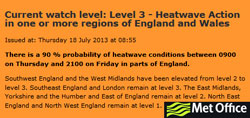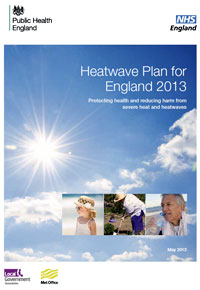Whilst most people are enjoying the current heatwave covering most of Europe as well as the UK, the same cannot be said for the conditions inside many UK workplaces.
 With ‘air conditioning’ being a concept British bosses seem to be unable to fathom, the majority of people at work are enduring temperature levels which can be hazardous to workers health, with elderly workers, pregnant women, asthmatics and those suffering from allergies; being the worst affected.
With ‘air conditioning’ being a concept British bosses seem to be unable to fathom, the majority of people at work are enduring temperature levels which can be hazardous to workers health, with elderly workers, pregnant women, asthmatics and those suffering from allergies; being the worst affected.
With temperatures outside hitting the 30s centigrade, the temperatures inside in some workplaces can hit as high as 40C!
Be under no illusions – heat can kill!
In England in 2003, there were over 2,000 excess deaths over the 10 day heatwave period which lasted from 4 – 13 August 2003, compared to the previous five years over the same period.
Whilst in France that year, unprecedentedly high day- and night-time temperatures for a period of three weeks resulted in 15,000 excess deaths. The vast majority of these were among older people.
So far in 2013, 760 deaths have been reported as a result high temperatures in the UK.
Labour MP Linda Riordan, has tabled an early-day motion which warns that employees in workplaces ranging from industrial bakeries to offices and school classrooms are often subjected to temperatures which impact seriously on their health and well-being.
Consequences of overheated workplaces can include "discomfort, stress, irritability and headaches, extra strain on the heart and lungs, dizziness and fainting and heat cramps due to loss of water and salt", and the resulting reduction in alertness and attention spans can contribute to workplace accidents and fatalities.
An official code of practice introduced in 1992 as part of the Workplace (Health, Safety and Welfare) Regulations states that workplace temperatures should not normally drop below 16C or 13C if the work involves severe physical effort.
 But there is no suggested maximum limit, with the guidelines stating only that "all reasonable steps should be taken to achieve a reasonably comfortable temperature".
But there is no suggested maximum limit, with the guidelines stating only that "all reasonable steps should be taken to achieve a reasonably comfortable temperature".
The TUC has backed a legal maximum temperature of 30C (86F) or 27C (81F) for those doing strenuous work - and Ms Riordan's motion urges the Government to adopt these levels in law. But even these levels can be considered too high in a country not known for mean temperatures hitting above 25 degrees C in normal circumstances.
The Halifax MP said ministers should "resolve uncertainty for employers about their duty to combat excessive heat in the workplace by introducing a maximum working workplace temperature of 30C and of 27C for those doing strenuous work".
The UK government issues a ‘Heatwave Plan’ every year, but despite this no action in workplaces seems to being taken and millions of workers just have to endure sometime dangerous levels of heat whilst in work.
The first Heatwave Plan for England was published in 2004 and since then we have had a significant heatwave in 2006 (when it was estimated that there were about 680 excess deaths compared to similar periods in previous years). In 2009 there were approximately 300 excess summer deaths during a heatwave compared to similar periods in previous years.
 In contrast to deaths associated with cold snaps in winter, the rise in mortality as a result of very warm weather follows very sharply – within one or two days of the temperature rising.
In contrast to deaths associated with cold snaps in winter, the rise in mortality as a result of very warm weather follows very sharply – within one or two days of the temperature rising.
This means that by the time a heatwave starts, the window of opportunity for effective action is very short indeed; and therefore advanced planning and preparedness is essential.
Despite all this, there is only one mention of workplaces in the whole Heat Plan and absolutely no guidance to employers as to their responsibilities and the actions they should be taking to minimise heat levels in the workplace.
Meanwhile back in Parliament:
To date the Early Day Motion has been signed by 12 Labour backbenchers, two SDLP MPs and one MP each from the Liberal Democrats, DUP and Plaid Cymru.
Early day motions are not debated on the floor of the house and have no prospect of becoming law, but provide an indication of the level of concern about an issue among MPs.
You can download the 2013 Heat Plan in from the E-Library database by clicking on the pic above and using the search word ‘heat’
Additionally guidance documents and the law on temperatures in the workplace can be found in the E-Library Database. Click the pic above.
The CWU's leaflet 'Sun Safe' can be downloaded here
Source: DWP / Daily Telegraph / Kath Quinn




 But there is no suggested maximum limit, with the guidelines stating only that "all reasonable steps should be taken to achieve a reasonably comfortable temperature".
But there is no suggested maximum limit, with the guidelines stating only that "all reasonable steps should be taken to achieve a reasonably comfortable temperature".